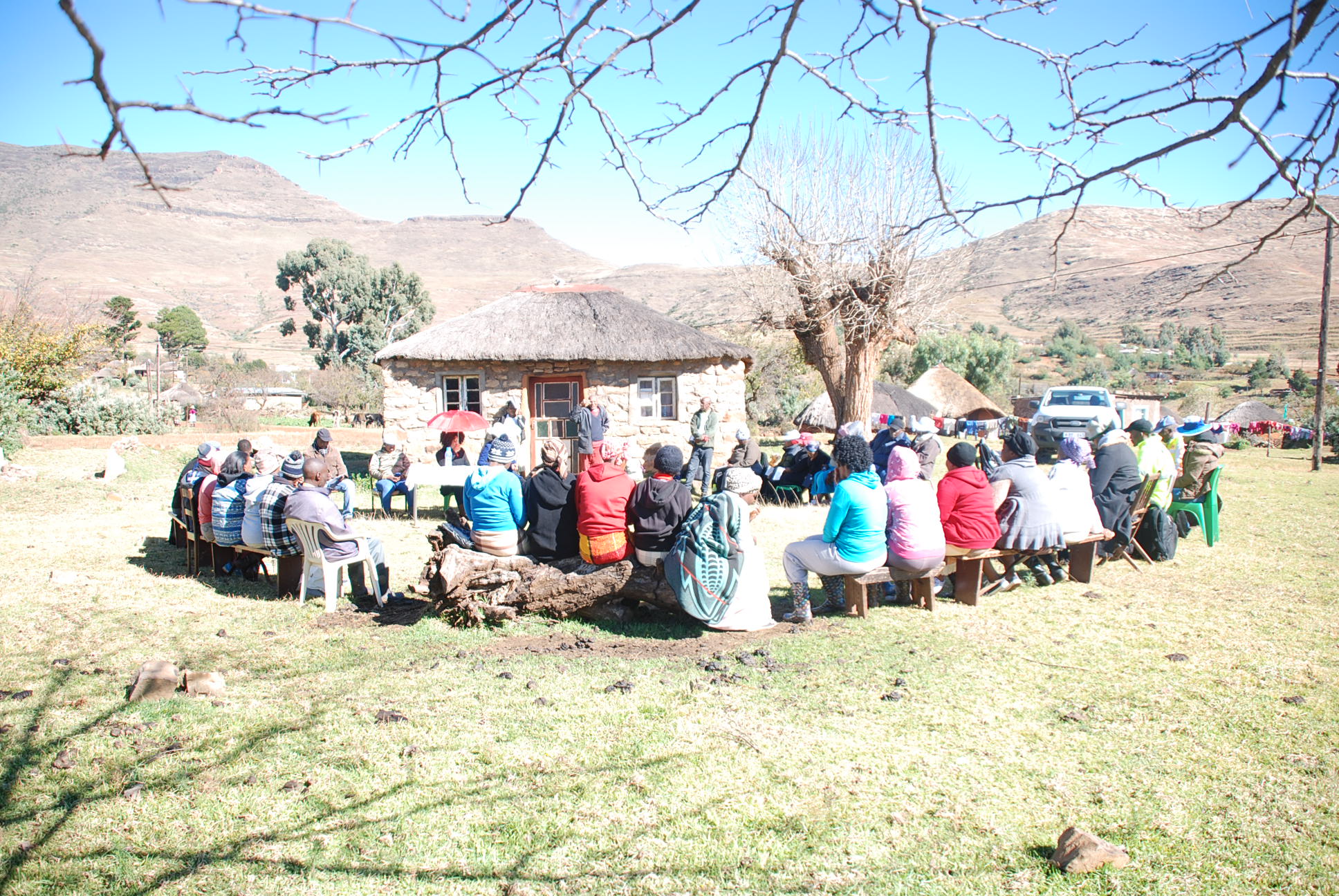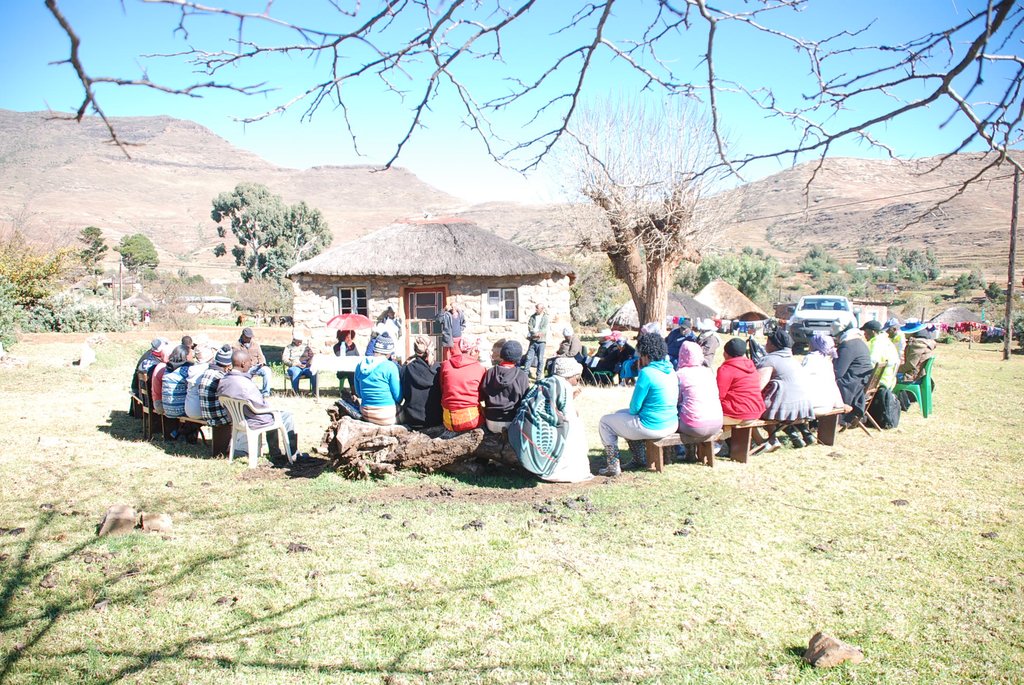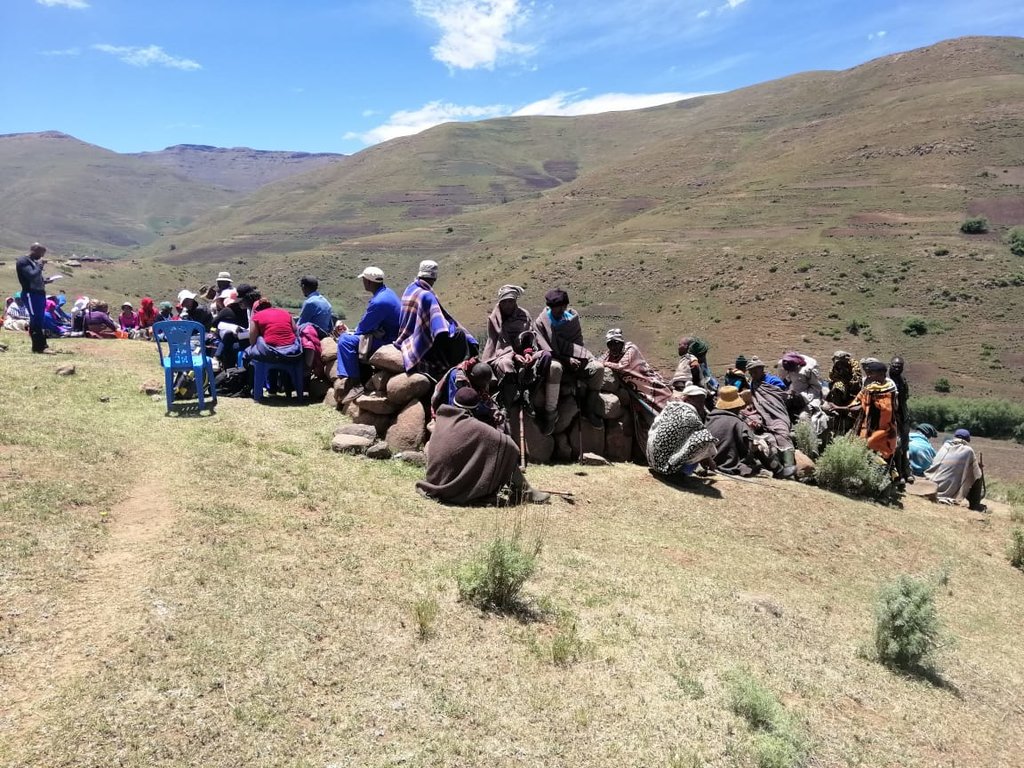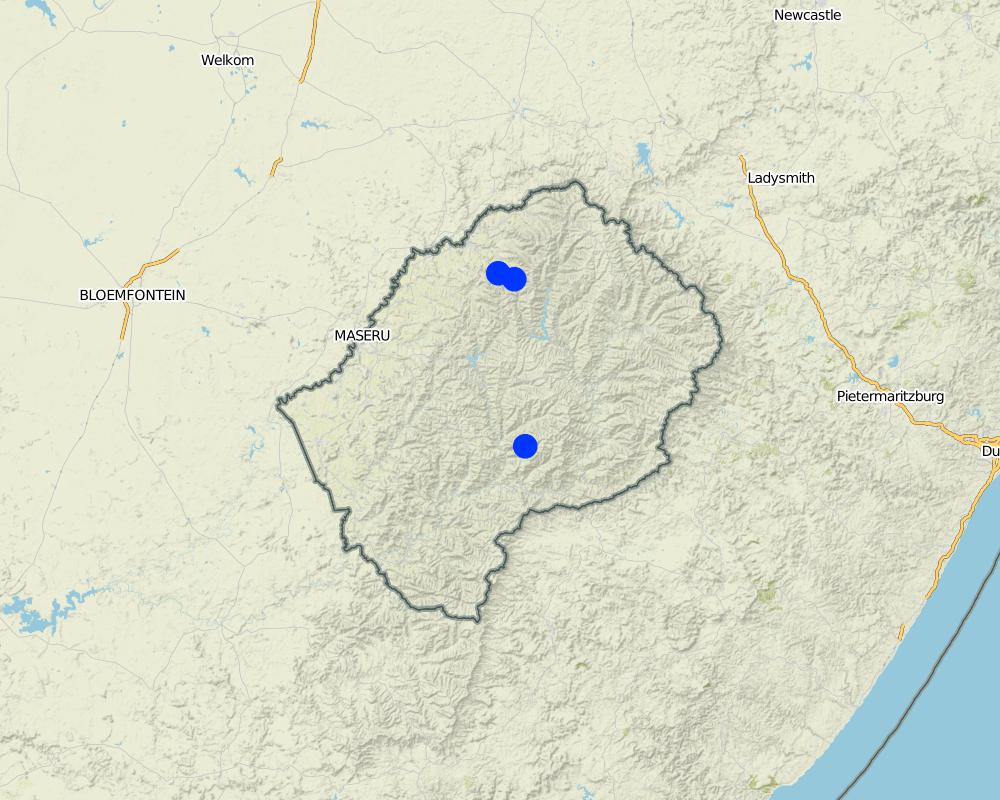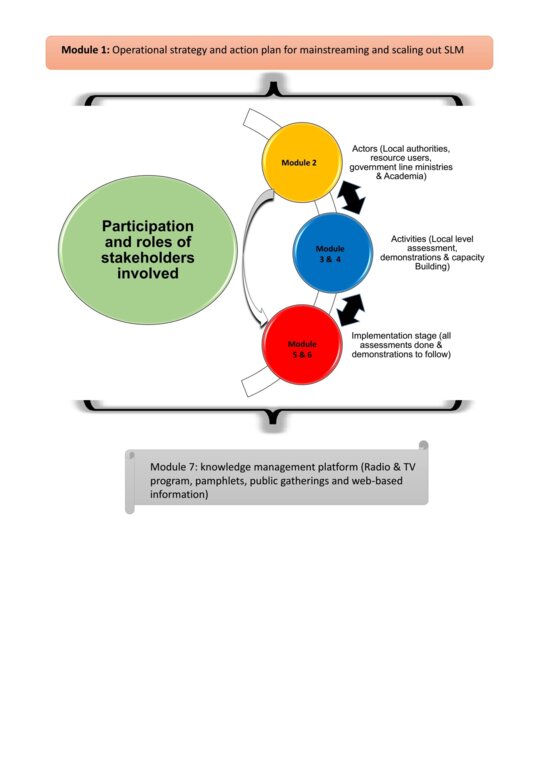Focus Group Discussion [Lesotho]
- Création :
- Mise à jour :
- Compilateur : Matoka Moshoeshoe
- Rédacteur : –
- Examinateurs : Rima Mekdaschi Studer, William Critchley
Pitso
approaches_4266 - Lesotho
Voir les sections
Développer tout Réduire tout1. Informations générales
1.2 Coordonnées des personnes-ressources et des institutions impliquées dans l'évaluation et la documentation de l'Approche
Nom du projet qui a facilité la documentation/ l'évaluation de l'Approche (si pertinent)
Decision Support for Mainstreaming and Scaling out Sustainable Land Management (GEF-FAO / DS-SLM)Nom du ou des institutions qui ont facilité la documentation/ l'évaluation de l'Approche (si pertinent)
Integrated Catchment Management Project (Integrated Catchment Management Project) - Lesotho1.3 Conditions relatives à l'utilisation par WOCAT des données documentées
Quand les données ont-elles été compilées (sur le terrain)?
27/05/2018
Le compilateur et la(les) personne(s) ressource(s) acceptent les conditions relatives à l'utilisation par WOCAT des données documentées:
Oui
1.4 Références au(x) questionnaire(s) sur les Technologies de GDT
2. Description de l'Approche de GDT
2.1 Courte description de l'Approche
This focus group discussion was composed of 15-20 participants: community elders, youth, (males and females as informed by local beliefs and norms), retired government officials.The aim of community focus group discussion was to find land users’perception and behaviour on land uses and SLM. It was organised by Ministry of Forestry, LADA coordinator and national consultant. The target group was land users, local authorities, youth, small stock owners, retired government officials. The target group mandate was also to draw the community map which also showed the land uses and resources. This focus group discussion gave researchers information on land uses, natural resources, prior SLM interventions, and many more.
2.2 Description détaillée de l'Approche
Description détaillée de l'Approche:
1. Conducted an initial field visit before the focus group discussion (FGD) with the selected villages within the sub-catchment: A tour by road with a few key informants to familiarise officers with the study area, land uses, also the extent and severity of degradation and types and extent of conservation and improved land management measures with the result being a community territorial map.
2. The aim of Focus Group Discussion (FGD) is to obtain information about range of land-users, their individual and communal management regime and the history of their area. This method is used as the first stage of implementation in LADA local level assessment.
3. The FGD representatives consisted of different social groups (i.e. both men and women – and different age groups) between 15-20 members. These members together with technocrats sat at round table set up which enabled free and interactive communication and feedback.
Each study area had its own list of FGD questions and facilitated them accordingly. Field Assessments confining; six (6) study areas in each sub-catchment.
•Vegetation assessment.
•Soil assessments which entail soil erosion and soil properties (2 study areas).
•Water resources assessment with key informant interviews on water resources.
•Household livelihood assessments.
•Land use systems
4. The target group mandate was also to draw the community map which also showed the land uses and resources. This focus group discussion gave researchers information on land uses, natural resources, prior SLM interventions, and many more. This approach enabled land users to present all their views without fear or dominance by other members. They realised that they have their resources in abundance, however, they need to improve their status as their livelihoods entirely depends on their good use.
5. It was organised by Ministry of Forestry, National University of Lesotho, Ministry of Agriculture, Ministry of Water, Ministry of Local Government,LADA coordinator and national consultant. The target group was land users, local authorities, youth, small stock owners, retired government officials.
6. The advantage of FGD was that the land users were taught on income generating activities such as orchard establishment, food processing, vegetable production under shade nets/tunnels (climate smart agriculture). They did not like the timing of FGD because it interfered with their haresting season, it took longer than it was intended and the weather conditions were not condusive as it was too cold and on the second day, snow began to fall.
2.3 Photos de l'approche
2.4 Vidéos de l'Approche
Commentaire, brève description:
No videos taken
Date:
13/12/2018
Lieu:
Maseru
Nom du vidéaste:
N/A
2.5 Pays/ région/ lieux où l'Approche a été appliquée
Pays:
Lesotho
Région/ Etat/ Province:
Southern Africa
Autres spécifications du lieu :
Focus group discussions were held in three different catchments (Ha Mahloane, Bolahla Pitseng in Leribe district, Lesobeng khutlo se-metsi catchment in Thaba-Tseka district and Ha mosuoe catchment in Quthing district.
Commentaires:
Bolahla-Mphosong catchment
Map
×2.6 Dates de début et de fin de l'Approche
Si l'année précise est inconnue, indiquez approximativement quand l'Approche a démarré:
il y a entre 10-50 ans
Date (année) de fin de l'Approche (si l'Approche n'est plus appliquée):
2030
Commentaires:
On-going
2.7 Type d'Approche
- fondé sur un projet/ programme
2.8 Principaux objectifs de l'Approche
To find land-users views on their status of their natural resources and if they have indigenous knowledge systems applicable to be used in the management method
2.9 Conditions favorisant ou entravant la mise en œuvre de la(des) Technologie(s) appliquée(s) sous l'Approche
normes et valeurs sociales/ culturelles/ religieuses
- favorise
socio-economic factors can hinder the application of this technology
disponibilité/ accès aux ressources et services financiers
- favorise
FAOLS country office assisted with finances
cadre institutionnel
- favorise
The Lesotho government has provided all conditions necessary
collaboration/ coordination des acteurs
- favorise
Other line ministries have fully participated
cadre juridique (régime foncier, droits d'utilisation des terres et de l'eau)
- entrave
Lesotho land tenure needs to be reviewed
cadre politique
- entrave
The Department of Soil and Water Conservation's policy is still in its draft form.
gouvernance foncière (prise de décisions, mise en œuvre et application des décisions)
- entrave
In Lesotho, land is communally owned
connaissances sur la GDT, accès aux supports techniques
- favorise
Farmer-Extension worker ratio is too high to enable adequate scaling up of SLM technologies
marchés (pour acheter les intrants, vendre les produits) et prix
- entrave
limited subsidies towards direct sourcing of specific inputs
charge de travail, disponibilité de la main-d'œuvre
- entrave
Farmer-Extension worker ratio is too high to enable adequate scaling up of SLM technologies
3. Participation et rôles des parties prenantes impliquées dans l'Approche
3.1 Parties prenantes impliquées dans l'Approche et rôles
- exploitants locaux des terres / communautés locales
farmers, traditional healers
participants
- Spécialistes de la GDT/ conseillers agricoles
soil scientists, agriculturalists, environmentalists and hydrologists
facilitators
- chercheurs
National University of Lesotho (natural resource management researchers)
facilitators/reseachers
- gouvernement local
Chiefs and Local councillors
community organisers
- gouvernement national (planificateurs, décideurs)
Soil and Water resource line ministries
planning, mentoring and decision support
Si plusieurs parties prenantes sont impliquées, indiquez l'organisme chef de file ou l'institution responsable:
Ministry of Forestry, Range and Soil Conservation
3.2 Participation des exploitants locaux des terres/ communautés locales aux différentes phases de l'Approche
| Participation des exploitants locaux des terres/ communautés locales | Spécifiez qui était impliqué et décrivez les activités | |
|---|---|---|
| initiation/ motivation | interactive | key informants as community representatives |
| planification | interactive | key informants and technocrats working together to produce community maps |
| mise en œuvre | interactive | technocrats tour guided by community elders |
| suivi/ évaluation | aucun | |
| aucun |
3.3 Diagramme/ organigramme (si disponible)
Description:
This flow chart describes participation of stakeholders in the implementation of DS-SLM activities in Lesotho
Auteur:
Koetlisi Koetlisi (PhD) and Matoka Moshoeshoe
3.4 Prises de décision pour la sélection de la Technologie/ des Technologies
Indiquez qui a décidé de la sélection de la Technologie/ des Technologies à mettre en œuvre:
- principalement les spécialistes de la GDT, après consultation des exploitants des terres
Expliquez:
Technocrats recommend SLM activities to land-users who in turn adopt the suggested technologies attributed to their impact land-users' livelihoods
Spécifiez sur quelle base ont été prises les décisions:
- l'évaluation de connaissances bien documentées en matière de GDT (prises de décision fondées sur des preuves tangibles)?
4. Soutien technique, renforcement des capacités et gestion des connaissances
4.1 Renforcement des capacités/ formation
Une formation a-t-elle été dispensée aux exploitants des terres/ autres parties prenantes?
Non
4.2 Service de conseils
Les exploitants des terres ont-ils accès à un service de conseils?
Oui
Spécifiez si le service de conseils est fourni:
- dans les champs des exploitants?
- dans des centres permanents
Décrivez/ commentez:
There are farmer-farmer visits facilitated by extension workers. There are also agriculture resource centres whereby farmers visit to get more information.
4.3 Renforcement des institutions (développement organisationnel)
Des institutions ont elles été mises en place ou renforcées par le biais de l'Approche?
- non
4.4 Suivi et évaluation
Le suivi et l'évaluation font ils partie de l'Approche? :
Non
4.5 Recherche
La recherche a-t-elle fait partie intégrante de l’Approche?
Oui
Spécifiez les thèmes:
- sociologie
- économie/ marketing
- écologie
Donnez plus de détails et indiquez qui a mené ces recherches:
Each researcher facilitated their area of speciality and this enabled the question-answer session to be easy. community members had bottle-necks which researchers ironed. The challenge in extension services is means of transport to the landusers due to terrain of our country, so extension service is somehow compromised and not acessible at all times.
5. Financement et soutien matériel externe
5.1 Budget annuel de la composante GDT de l'Approche
Si le budget annuel précis n'est pas connu, indiquez une fourchette:
- 2 000-10 000
Commentez (par ex. principales sources de financement/ principaux bailleurs de fonds):
FAO-UN
Government of Lesotho
The money caters for accomodation, meals, transport, refreshments for researchers. This is because reseachers do not reside where the FGD was taking place, after the FGD followed LADA local level assessment, which was conducted for 15 days.
5.2 Soutiens financiers/ matériels fournis aux exploitants des terres
Les exploitants des terres ont-ils reçu un soutien financier/ matériel pour la mise en œuvre de la Technologie/ des Technologies?
Non
5.3 Subventions pour des intrants spécifiques (incluant la main d'œuvre)
- aucun
Commentaires:
N/A
5.4 Crédits
Des crédits ont-ils été alloués à travers l'Approche pour les activités de GDT?
Non
5.5 Autres incitations ou instruments
D'autres incitations ou instruments ont-ils été utilisés pour promouvoir la mise en œuvre des Technologies de GDT?
Oui
Si oui, spécifiez:
There are policies and laws which were referred to in order to support SLM such as Forest Act (1998), Range Resources Management policy (2013)
6. Analyses d'impact et conclusions
6.1 Impacts de l'Approche
Est-ce que l'Approche a permis la prise de décisions fondées sur des données probantes?
- Non
- Oui, un peu
- Oui, modérément
- Oui, beaucoup
participants exchanged information without any hindrance as they were able to learn based on their baseline knowledge
Est-ce que l'Approche a aidé les exploitants des terres à mettre en œuvre et entretenir les Technologies de GDT?
- Non
- Oui, un peu
- Oui, modérément
- Oui, beaucoup
Land users were only given a theory on the importance of SLM technologies not how technologies are constructed. other researchers were novice in land management, it is though this approach where they learned facilitation skills. In Lesotho, land management activities are implemented mostly by women, youth and elderly because men in the villages work in South African mines. The picture of FGD also portrays more women than men
Est-ce que l'Approche a amélioré la coordination et la mise en œuvre de la GDT selon un bon rapport coût-efficacité?
- Non
- Oui, un peu
- Oui, modérément
- Oui, beaucoup
This was not part of the agenda
Est-ce que l'Approche a amélioré les connaissances et les capacités des exploitants des terres pour mettre en œuvre la GDT?
- Non
- Oui, un peu
- Oui, modérément
- Oui, beaucoup
It was agreed that participants would take part in demonstrations that would be implemented later in their respective communities
Est-ce que l'Approche a amélioré les connaissances et les capacités des autres parties prenantes?
- Non
- Oui, un peu
- Oui, modérément
- Oui, beaucoup
All stakeholders in the natural resources management had a chance to discuss collectively- not in silos, issues that concerned them
Est-ce que l'Approche a construit/ renforcé les institutions, la collaboration entre parties prenantes?
- Non
- Oui, un peu
- Oui, modérément
- Oui, beaucoup
All stakeholders in the natural resources management had a chance to discuss collectively- not in silos, issues that concerned them. Presence of researchers strengthened this collaboration.
Est-ce que l'Approche a autonomisé les groupes socialement et économiquement défavorisés?
- Non
- Oui, un peu
- Oui, modérément
- Oui, beaucoup
Est-ce que l'Approche a amélioré l'égalité entre hommes et femmes et autonomisé les femmes et les filles?
- Non
- Oui, un peu
- Oui, modérément
- Oui, beaucoup
all levels of society were represented
Est-ce que l'Approche a encouragé les jeunes/ la prochaine génération d'exploitants des terres à s'engager dans la GDT?
- Non
- Oui, un peu
- Oui, modérément
- Oui, beaucoup
The youth were also represented
Est-ce que l'Approche a amélioré les questions foncières et des droits d'utilisation qui entravent la mise en œuvre des Technologies?
- Non
- Oui, un peu
- Oui, modérément
- Oui, beaucoup
Lesotho land tenure issues need to be addressed at national level
Est-ce que l'Approche a conduit à améliorer la sécurité alimentaire et/ou la nutrition?
- Non
- Oui, un peu
- Oui, modérément
- Oui, beaucoup
Officers from Ministry of Agriculture through extension, delivered issues of nutrition and food security
Est-ce que l'Approche a amélioré l'accès aux marchés?
- Non
- Oui, un peu
- Oui, modérément
- Oui, beaucoup
There is abundance of natural resources in this area. Members were made aware of markets opportunities around them
Est-ce que l'Approche a conduit à améliorer l'accès à l'eau et l'assainissement?
- Non
- Oui, un peu
- Oui, modérément
- Oui, beaucoup
Officers from Ministry of Water advised on issues of water and sanitation
Est-ce que l'Approche a conduit à l'utilisation/ sources d'énergie plus durables?
- Non
- Oui, un peu
- Oui, modérément
- Oui, beaucoup
The community entirely depends on the natural resources for better livelihoods
Est-ce que l'Approche a amélioré la capacité des exploitants des terres à s'adapter aux changements/ extrêmes climatiques et a atténué les catastrophes liées au climat?
- Non
- Oui, un peu
- Oui, modérément
- Oui, beaucoup
Climate change issues were also discussed and participants were made aware of the effects.
Est-ce que l'Approche a conduit à des emplois, des opportunités de revenus?
- Non
- Oui, un peu
- Oui, modérément
- Oui, beaucoup
Key informants were asked about their means of livelihoods in the area. This opened income opportunities to some members
6.2 Principale motivation des exploitants des terres pour mettre en œuvre la GDT
- augmenter la production
Land productivity has been declining attributed to land degradation. SLM is seen as the only measure to help farmers in increasing their production
- réduire la dégradation des terres
Lesotho's landscape is severely eroded. Land users would like use SLM as an approach to halt land degradation
6.3 Durabilité des activités de l'Approche
Les exploitants des terres peuvent-ils poursuivre ce qui a été mis en œuvre par le biais de l'Approche (sans soutien extérieur)?
- incertain
Si non ou incertain, spécifiez et commentez:
Without external support, farmers are not able to implement activities fully
6.4 Points forts/ avantages de l'Approche
| Points forts/ avantages/ possibilités du point de vue de l'exploitant des terres |
|---|
| Knowledge management |
| It can easily be implemented |
| It brings different land user groups together |
| Points forts/ avantages/ possibilités du point de vue du compilateur ou d'une autre personne ressource clé |
|---|
| other key resource persons such as local authorities liked this approach because it them ideas on which resources are available in the catchment and how communities utilise them for survival. The land users on the other hand ound this approach very useful as they were empowered and allowed to say their views without fear or favor as they were informed that there were no wrong answers. everybody participated fully |
6.5 Faiblesses/ inconvénients de l'Approche et moyens de les surmonter
| Faiblesses/ inconvénients/ risques du point de vue de l’exploitant des terres | Comment peuvent-ils être surmontés? |
|---|---|
| It is limited to key informants | It should be replicated within the same community but, with different participants (Key) |
| Some key informants tend to dominate the discussion | The facilitator should be observant and try to control dominating participants |
| It may become a platform for conflicts | Local authorities should be present in case conflicts arise |
7. Références et liens
7.1 Méthodes/ sources d'information
- visites de terrain, enquêtes sur le terrain
15-25 informants, these are representatives of each village whereby each village was represented by 2/3 participants. these are the people who formed FGD
- interviews/entretiens avec les exploitants des terres
10% of total households per catchment
7.2 Références des publications disponibles
Titre, auteur, année, ISBN:
N/A
7.3 Liens vers les informations pertinentes disponibles en ligne
Titre/ description:
Ministry of Forestry, Range and Soil Conservation
URL:
https://forestry.gov.ls
Titre/ description:
Lesotho Soil Information System
URL:
https://lesis.gov.ls
Liens et modules
Développer tout Réduire toutLiens
Aucun lien
Modules
Aucun module trouvé


